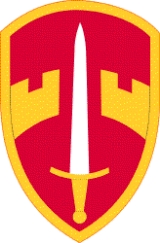
Military Assistance Command, Vietnam
Overview
United States
The United States of America is a federal constitutional republic comprising fifty states and a federal district...
' unified command structure for all of its military forces in South Vietnam
South Vietnam
South Vietnam was a state which governed southern Vietnam until 1975. It received international recognition in 1950 as the "State of Vietnam" and later as the "Republic of Vietnam" . Its capital was Saigon...
during the Vietnam War
Vietnam War
The Vietnam War was a Cold War-era military conflict that occurred in Vietnam, Laos, and Cambodia from 1 November 1955 to the fall of Saigon on 30 April 1975. This war followed the First Indochina War and was fought between North Vietnam, supported by its communist allies, and the government of...
.
MACV was created on February 8, 1962, in response to the increase in U.S. military assistance to South Vietnam. MACV was first implemented to assist the Military Assistance Advisory Group
Military Assistance Advisory Group
Military Assistance Advisory Group is a designation for American military advisers sent to assist in the training of conventional armed forces of Third World countries. Before and during the Vietnam War, there were three of these groups operating in Southeast Asia...
(MAAG) Vietnam, controlling every advisory and assistance effort in Vietnam, but was reorganized on May 15, 1964 and absorbed MAAG Vietnam to its command when combat unit deployment became too large for advisory group control.
The first commanding general of MACV
COMUSMACV
COMUSMACV was a U.S. military abbreviation during the Vietnam War standing for Commander, U.S. Military Assistance Command, Vietnam. COMUSMACV was in one sense the top person in charge of the U.S. military on the Indochinese peninsula; however, in reality, the CINCPAC and the U.S...
, General Paul D. Harkins
Paul D. Harkins
Paul Donal Harkins was Deputy Chief of Staff during World War II to George S. Patton Jr. and later became a U.S. Army General and the first Military Assistance Command, Vietnam commander from 1962 to 1964.-Early life:...
, was also the commander of MAAG Vietnam, and after reorganization was succeeded by General William C. Westmoreland
William Westmoreland
William Childs Westmoreland was a United States Army General, who commanded US military operations in the Vietnam War at its peak , during the Tet Offensive. He adopted a strategy of attrition against the National Liberation Front of South Vietnam and the North Vietnamese Army. He later served as...
in June, 1964, followed by General Creighton Abrams
Creighton Abrams
Creighton Williams Abrams Jr. was a general in the United States Army who commanded military operations in the Vietnam War from 1968–72 which saw U.S. troop strength in Vietnam fall from a peak of 543,000 to 49,000. He served as Chief of Staff of the United States Army from 1972 until shortly...
(July 1968) and General Frederick C. Weyand
Frederick C. Weyand
Frederick Carlton Weyand was a U.S. Army General. Weyand was the last commander of US military operations in the Vietnam War from 1972–1973, and served as the 28th US Army Chief of Staff from 1974-1976.-Early career:...
(June 1972).
With the signing of the Paris Peace Accords
Paris Peace Accords
The Paris Peace Accords of 1973 intended to establish peace in Vietnam and an end to the Vietnam War, ended direct U.S. military involvement, and temporarily stopped the fighting between North and South Vietnam...
all American and third country forces were to be withdrawn within 60 days of the cease-fire.

